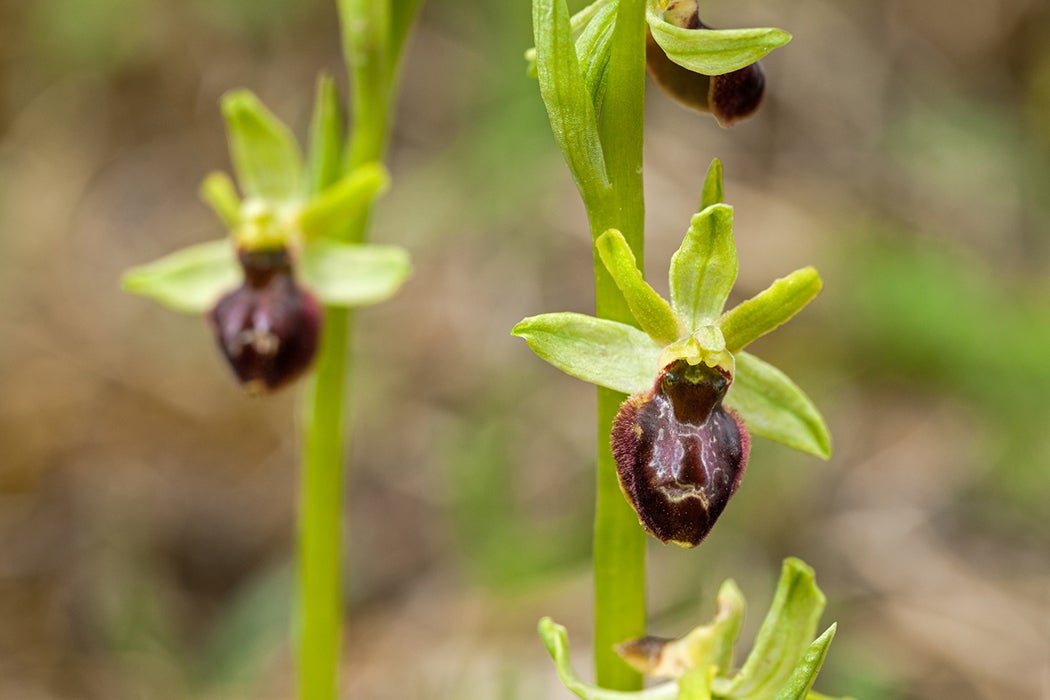The early spider orchids native to many parts of Europe, Great Britain and Middle East, are in trouble. Due to the rising temperatures and climate change, the species has fallen out of step with its old-time love partners—the bees. And so over the past few decades these delicate flowers have been disappearing from the grounds they used to thrive in.
Scientifically known as Ophrys sphegodes, these orchids have a special relationship to Buffish Mining-bees. Their flowers emit an aroma that imitates the scent of a female Buffish Mining-bee. The smell attracts male bees, who try to mate or pseudocopulate with the flower. In the process, the male bee picks up the flower’s pollen, which it then transfers to several other flowers. The orchids and bees have had this pseudo-romance going on for generations, but rising temperatures are throwing a kink in their timing, say researchers at the University of Sussex who have just published a 32-year long study of this intricate relationship.
Typically, the orchids flowered shortly before the male Buffish Mining-bees would start to fly. The male bees would emerge from their winter hibernations and buzz around for about a week before their female counterparts. During this week without mates, the males would be lured into pseudocopulation by the blooming orchids. As a result, they unwittingly assured that the flowers were pollinated, and would return year after year. The timing was perfect. The orchids have evolved to bloom earlier than bees fly, “so that competition for the services of naïve male bees is avoided,” the researchers wrote.
With winters and springs getting warmer, the orchids bloom sooner and the bees fly earlier, but their timing is out of sync. The bees now emerge nearly a week before the orchids blossom. The female bees tend to achieve their peak flying time more than a week before orchids reach their peak flowering date. Naturally, the male bees prefer to copulate with female bees, and the orchids are ignored.
The delicate relationship didn’t just change overnight. It has been slowly getting out of sync since the seventeenth century, says study author Michael Hutchings at the University of Sussex. His team used the Central England Temperature (CET) temperature records of the last 350 years, matching it to the records on the orchid blossoms and the bee flights, dating back to the nineteenth century.
The temperature fluxes affected the bee-orchid romance before, but not as intensely and less often. For example, between 1659 and 1710, the peak flying date of female bees preceded peak orchid flowering in 40 percent of the years. However, from 1961 to 2014, this figure doubled, leaving the orchids with very few years of successful procreation. For every 1°C rise in spring temperature, the peak flying dates of male bees occur nine days earlier and female bees two weeks earlier, but the orchids lag behind, peaking only six days earlier than before.
The problem is hardly limited to the spider orchids, Hutchings says, it’s much more widespread. The changing climate is likely altering other centuries-long relationships between many other species whose pollination depends on certain insect types.
“It is likely that many other species dependencies are also suffering from climate-induced changes to their life cycles. While this is especially bad news for the early spider orchid, the devastating impact of climate change is in all likelihood harming the delicate interdependent relationships of many species,” Hutchings says. “Climate change could threaten many other ecological interdependencies, including birds depending on caterpillars being available as food immediately after hatching and insects needing specific nectar sources.” It may also threaten the crops human grow for food, and other important cultivars we depend on.







